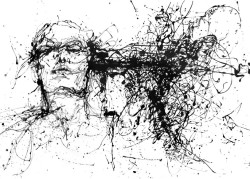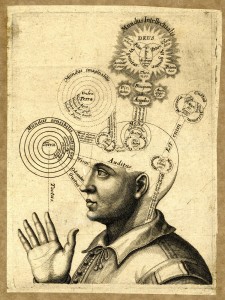Many have already noticed that humankind has reached a point where our mindset is leading to our own destruction. Time has come to realize this urgent fact and take action, one that will guide us into a better evolution. Art can be a tool for comprehending the shifts in consciousness which humankind has been through and show us how we can reach a new understanding collectively, one that can save ourselves from destruction through a new evolution of consciousness.
During the Renaissance, art helped humans evolve their consciousness with the invention of a new perception of space: Perspective. Before this shift in mind and vision we could only picture things in two dimensions. Man was bonded with nature. With perspective, a whole new mental age awakened. Space was abstracted and thought of in three dimensions.
This new knowledge began separating man from nature by creating individual identity through Reason, and this great shift in consciousness lead to the evolution from the magical/mythical conception of things to the mental age. Art was the perfect tool for the collective sharing of that understanding.
When we begin to perceive things in a context created by our minds we become detached from it. We order and frame things to understand them according to a mental system. Art, History, Time, Space, are all conceptions created by our minds to order and share a common understanding so we can evolve. We have seen that this way of thinking has brought us to a crisis, where anxiety and destruction are not far. But we can change that if we realize intellectualization has taken us apart from nature, the original force, and lead us to a separation from spirit, what originally fulfills us integrally.
If we take a step back to see that all the basic building blocks of our knowledge are but conceptions created to construct a collective understanding, if we detach ourselves from this context, we can see that everything is spaceless and timeless, and become awakened to evolve.
Abstract art can help us reach this awakening.
Dualism separates subject and object. It is the basic mental system we use since Descartes invented it. It leads to the creation of conceptions that imprison objects to the meanings created by the mind.
Abstract art is free from fixed meanings. Instead of creating a representation based on pre-given conceptions like in conceptual or figurative art, abstract art is open to interpretation. Each person gives their own meaning to what they see. Subject and object are fused as one. When we see that, we understand that we can transcend the fixed meanings and be one with the world again.
Modern times are times of great anxiety, the great world wars showed us that something was wrong with our way of thinking. Artist of the Modernist movements expressed this feeling of the times as they tried to dissolve everything we knew as pictorial representation and create new understandings of space and time. Their will to dissolve everything was also a feeling reflected in Science with Quantum Physics, the study of the micro parts of our universe.
We should break down all we have been through so we can reach the understanding that we should go back to the origin, where everything is integrated. It may seem paradoxical, this breaking down of things in order to evolve, but actually this notion of going back and forth in time does not exist.
Quantum Physics showed us the existence of parallel universes that are all around at the same time. So we don’t need to go back to origin. Origin is ever-present. This is the spiritual, awakened state we want to reach collectively. The whole, time-free and spaceless present.
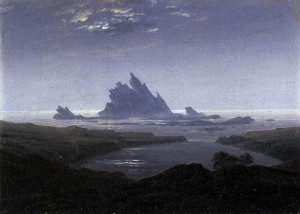
Art is a marvelous tool to show us what is behind rationality by using it do so. Early Realism brought the idea of man in space by picturing sublime landscapes, it brought the feeling of man alone in the landscape, longing for something. But what? That was the birth of the notion of time based on man’s experience of the soul. Before, time was experienced spiritually instead of rationally. It was not measured or abstracted but felt.
Time:
Man’s first sensation of time came from the earth’s movements of the night sky that were measured to order and understand the rhythm and dynamics of nature. The dualization of time (night/day) brought to the dualization of space (near/far). Space was then created by our notion of time. For example, the time it takes to go from one place to another. So in this way the progressive, spatial, notion of time came to be.
With this knowledge man grew apart from nature and began to abstract time. It was the first bounding to rationality, or to the mythical realm, which first separated man and nature and brought to the awakening of the soul. With this understanding of the dynamics of nature, man becomes aware of his individuality and subjectivity and the consciousness of soul is born.
Soul and spirit were understood as one at first, but with the advancement of individuality, soul became subjective and spirit became the whole. We abstract a piece of the whole spirit to better understand it through the concept of soul. Like any abstract, it is a concept we create to lead us to a certain understanding.
We have the need to concentrate our attention on a certain thought to make it real. If we concentrate our attention on a thought, like faith in religion, or a concept in art, we can channel our energy and it may bring to a new mindset. Like in a Rothko piece, for example, the forms brings us in touch with our inner selves and this thought may bring us to an awakening.
No awakening of consciousness can take place without projection. Our ego has the need to project thoughts to reach an understanding. But we will only fulfill the awakened state of the new and last consciousness evolution if we break free from our ego to reach the integral structure, where there is no dualism, everything is one and whole.
We are all instruments for creating reality. That is why we should do so. Time projected and seen as a chronological order lead us to anxiety and the feeling that we will never reach what we are searching for. This notion of time is an obstacle to the perception of the timeless and spaceless universe that is the integral. We should perceive time as a quality or intensity in order to reconnect with nature.
Each one of us has a different experience of time depending on the context we are living in. Because time and space are conditional realities, they are intensities, they depend both on the objective and subjective, therefore they are integral. Intensities cannot be measurable, when we do so we fragment them and abstract them. Like the concept of time. It is our task to save time from its rational distortion.
Einstein began to overcome the dualism of space and time by presenting them as a space-time continuum on his Theory of Relativity, where matter and energy are different manifestations of the same thing. Everything is made of energy. Quantum Theory later showed that particles behave in a different way when in the presence of an observer. So we have come to the conclusion that we can change matter just by focusing our attention. That means the way we perceive things determines the way we see reality.
Biology has also been influenced by this awakening of a new mentality. The idea of “The Web of Life” sees nature as an integrated system, interconnected. Psychology also began to be more explored after the break with religious ties. After the “Death of God” man began to explore inside himself and discovered the unconscious. Time was the unknown and it had to be revealed by quantification, a result of man’s need to determine and “know” things.
When we realized that time as we know it is an invention we began to see it as intensity. Jung acknowledged the existence of “parallel universes” in his theory of Archetypes, which underlie a synchronicity of time. Archetypes personify the instinctual characters of the primitive psyche, the invisible roots of consciousness. They are an eternal presence and it depends if consciousness sees it or not. They exist before time, so they are time-free.
Philosophy began with the Greek thinkers at the moment of mutation from the mythical to the mental consciousness. Heidegger’s apocalyptic existentialism reveals the anxiety about existence brought by the mental age. He broke down the object (ontology) with fundamental analytics.
With Husserl and Phenomenalism the focus moved from the object to the subject. It turned it into a more personal approach, concerned with the essence of things in its relation to the individual. For this way of thinking it all depends on our consciousness. Things are determined by the experience of the viewer and not the other way around. Philosophy changed from a limited, perspectival mode of realization to become open, aperspectival and arational. The analytical method is taken over by a more spiritual manifestation. The phenomenon is valued as an intensity now.
Art also follows this path. This open, transparent experience shows there are no absolutes. Open philosophy has no ideological tendencies. It works with open concepts, interconnected and interchangeable, and liberates us from the prison of fixed concepts.
This turn toward transparency, the whole, comes with the renunciation of conceptualization. We understand that there are things, experiences, that go beyond words, beyond our rational understanding. The object is dissolved into essence, which needs our presence to make it concrete. Truth then is not a given, it depends on the intensity of its manifestation to become real.
Transparency shows us everything is relative. Even the law system is beginning to change with this opening of the mind. During the French Revolution the laws created were mainly deterministic, quantified, based on the subject as an abstract of life.
With the rise of Socialism, Hegel and Marx began to see time as quality, based on the experience of the individual. The renunciation of the analytical, patriarchal principle opened to a liberation to the left. Events were not seen as happening in machine-like conditions anymore, they were meaningful.
Time began to be seen as a potential of all possible manifestations. The idea of time as quality brings us to the present. It presents its own truth; it doesn’t need to come from an abstract concept anymore.
Arts:
Reality was taken as an excerpt from life and turned into a concept or representation since the very beginning of humankind through Art. Cave paintings already revealed the need of projection to understand reality. But at that time humans and nature were bonded.
We can also see this bond represented in Egyptian art where they depicted reality in a two-dimensional way. There was no mental separation of man and environment. Everything was united in a flat surface. With the evolution of the “I” space was objectified and turned into an idea. Perspective created a new representation of space.
The more we create abstract models to build our understandings from, the more we are limiting our capacity to know the whole. By choosing a certain lens to see through, we leave all the rest out. Perspective, for example, was a tool for man to understand himself and develop his individuality, but at the same time it distances him from nature by objectifying the world.
This fragmentation and isolation brought anxiety and crisis. Many artists tried to show that reality was within ourselves and we didn’t need to feel imprisoned to the basic concepts that build our knowledge in order to exist, since they were bringing bad experiences of destruction.
Picasso and Braque tried to show that time was not an absolute, we could see reality as atemporal and spaceless. Through Cubism they demonstrated the multidimensional, timeless world of the whole. By seeing time as intensity we can see space through every direction, transparent.
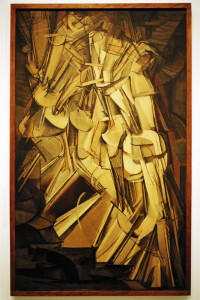 We acknowledge that space and time, materiality and spatiality as concrete constructions of our minds, when they are actually energy. We materialize them through our conceptual way of seeing to create reality. We try to dominate life by conceptualizing it, but we have already seen that this only brings to anxiety and destruction, so we should try to stop conceptualizing nature and give in to the whole.
We acknowledge that space and time, materiality and spatiality as concrete constructions of our minds, when they are actually energy. We materialize them through our conceptual way of seeing to create reality. We try to dominate life by conceptualizing it, but we have already seen that this only brings to anxiety and destruction, so we should try to stop conceptualizing nature and give in to the whole.
Art can bring to us, through intuition, or emotions, new perceptions that can free us from mental thinking. We see that there are many things that we can’t describe in words but have a great effect on us. Through abstract art we can feel the universal because it is open. Even though our need to conceptualize always tries to find a representation or an idea on abstract art, it is incommensurable, like nature.
“In the Here and Now everything is Absolute” – Vedas
Abstract art can be absolute because it is timeless. It is inserted in the here and now. It can be abstracted and framed according to a point of view for each person, but it can never be completely fixed. It will always change depending on each experience and interpretation. Realism, on the other hand, expects everyone to see it the same way.
We should take a step back and contemplate the forms as they are, not as our conceptual mind turns it to be. In abstract art we can contemplate freely, let the thoughts come to our mind and they will show us who we are. Like in meditation, it can provoke self-awareness, experiences that may lead to an awakening.
Music can also be contemplated as such. If we leave the fixed patterns of rhythm and create a tempo based on intensity, it may seem abstract, but we will be able to feel it more, since it may create expectations, painting moods. Some music approach an absolute freedom in harmony, melody, rhythm and form. (Ex: Schoenberg, “Six Pieces for Piano”)
Tonality in music is like perspective in painting, both overcome dualism to embrace the intensities and qualities of life. Many will not understand it because they are used to listen through a rational systematization. But we should just give in and embrace these attempts of humankind to awaken into aperspectivity and let the spiritual run freely.
Architecture is the pre-eminently sociological art, even more than music. Music builds and sustains the community through emotion. Contemporary architecture determines the mode of social life. The Bauhaus is an example of the dissolution of perspective and the transformation of space into space-time.
A new sense of spacing appears referencing the effects of mechanization and automobiles, just like in Futurism. Time and space are represented aperspectivally. The inclusion of the dynamic time-element dissolves and loosens the rigid space and makes it fluid, like in Niemeyer’s organic forms. Transforming rigid, closed forms into dynamic, open space.
Dualism is overcome when the opposition of interior and exterior is overcome. They become transparent with their glass walls and open interiors. Everything becomes integrated. By its side painting with artist like Fernand Léger who exploded the walls of the gallery space. Painting 3D forms on its walls and leaving the closed spatiality behind, opening up space where there once was an enclosed wall.
Delacroix was the first to use color as an emotional tonality. The use of complementary colors can work deep realms of our consciousness and bring up emotions beyond rationality. Delacroix rejects the line since they don’t appear in nature and exists only in man’s brain.
Cézanne breaks with the Renaissance notion of space as a line (perspective) and brings the notion of space as a curve, a spiral continuum. This new perception has the nature of a mutation from the three dimensional, where an exterior point is created by abstraction, to the fourth dimensional, integral. The work of art integrates itself with the universal rhythm; it is no longer a closed world outside of natural time and space, frozen in autonomy.
In Cézanne, art becomes an integrated component of the universe in motion. In his still lives we can see the object from above and in profile at the same time. Modern painting does not discharge perspective but overcomes it. In the fourth dimension space is spherical, depth becomes a dynamic continually changing process.
Time then appears integrated. By overcoming perception and other rational systematizations, Cézanne broke with the subject/object dualism of the viewer/painting. Integrating the viewer with the painting by making him feel instead of rationally reading the picture. Just like in Cubism, the viewer is present.
This bringing of the viewer and art together is a main concern in Contemporary Art. Minimalism, Performance, Color Field Painting, Relational Art, many artists follow the idea that the viewer is needed to complete the piece. Minimalism’s theatricality depends on its audience, and so does performance, even if it is recorded to be seen afterwards. The great canvases of abstract expressionism’s Color Field movement, like in Barnett Newman’s large canvases, provokes the viewer to contemplate and reach within themselves to find a meaning, bringing self-awareness. So does the great light installations of James Turrell for example, where perception is brought to mind and presence is awakened. Relational Art is physically dependent on the viewer’s participation as well, interactive pieces are a great part of this movement that ranges from artists like Yoko Ono to Rikrit Travanija.
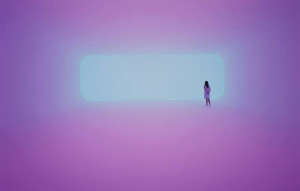
Art connects with us in other dimensions, beyond rationality. Unconscious connections can be made and new realities may be created. Imagination is the key to transform things. Objects that are commonly known under one meaning can be transfigured into other things with completely different uses and senses. Art can show us what is behind what we are used to see, it can show us the roots of our world. Invisible to the mere eye, the secret structure of things. Everything depends on how we see it. The essence of things are within ourselves. So we can change the lens we are seeing through and see the world in a different way. We can create our own reality.
Language also reflects the structural and mutational changes taking place. Poetry is a writing of history of the dateless, the record and declaration of invisible events, essences and emotions. In Holderlin, time becomes present. Language turns from description into utterance to fully express intensity and significance. A declaration of heightened awareness. Words become treated as quality, instead of being just means to an end. Words are not only reference anymore but exist in themselves as entities without the need of a context.
Emotions and physical feelings become part of the prose and time irrupts with the spatially intangible, it reaches far from the physical world deep into our soul integrating to the spirit of things. The energies of the psyche, once negated by rationalism, become the content of the novel. This leads to the stream of consciousness movement in Literature.
Proust breaks with time as progression presenting it relatively. Then, dualism of the subject and the exterior world is left behind by the relation of the subject and the world within, where time is subjective. Past and future are present in the now and time is integrated. James Joyce in “Ulysses” also shows the now as the parallel happening of past and future and everywhere at the same time. Space and time are exploded into integral openness and eternity becomes present. Released from its mere individual meaning, we turn into a participant in the whole significance of the world, on the greater network of interconnections, beyond time. This is spiritual.
New Positions:
Consciousness is what makes us aware of ourselves. Without it we would be like zombies. If we take a step back we may see that our ego is just one part of our consciousness, if we do that we can evolve. Art can help us achieve this knowledge by showing that many things we take as a given are just projections of our mind and can change according to how we see them. With that lens we understand that there are many other dimensions beyond what we usually perceive, filtered by rationality. With this realization we will be free to experience the unknown fully. If many people share this feeling it becomes universal and much more powerful.
You may ask, but how can we know when something is true or real? You feel it. When events merge into a unifying context we consider it real. You feel it as a vital experience. You know, you believe, and that makes it real. If we can’t grasp the experience then it is not real. But we don’t need to imprison experiences rationally to grasp them. Just feel. Feel the unifying power of making sense. If we can channel this belief and expand it universally it can be very powerful. We need to make everyone see that so we can evolve.
This vital experience of feeling the truth comes with an arational way of thinking. Rationality is just a projection so we don’t feel it deep within ourselves. We should perceive things with our hearts instead of our minds, and that is not going back to uneducation, in the contrary, it is evolving. We should be aware of all the ways we can perceive reality and choose how we want to live it, that is evolution.
The awakened consciousness will only be effective when everyone shares it, participate in it universally. Mutational periods are times of disturbance and even destruction. Man is the vessel to bring a new possibility for the world. We should connect to this new way of thinking, as fast as possible, before it keeps destroying things to show us that this is not the way. We may recognize the new consciousness as sense fulfilling and understand that is the right way to go. The future is immanent in us.
Humans always have the need of an exterior representation to show the way. Many came in human form, like Jesus, Plato, etc. But now we don’t need representations anymore, we can find the truth within ourselves. We just need to believe and connect to reshape the world. Faith and knowledge, religion and science, everything merges into one as we seek for the truth that emerges from belief. Reality is what we believe in!
When we become able to renounce the exclusive claim of the mental structure, like mental man renounced the mythical and mythical man renounced the magical, we will be able to evolve into aperspectivity. But it does not mean mythical or mental mindsets should cease to exist, they overlap in the understanding that all exists as one integral consciousness structure. The integral is the connection and evolution of the past mind sets all together. We may see now beyond each structure to understand everything together. The presence of the beyond in the here and now, of death in life, the transcendent in the immanent, the divine in the human, everything becomes transparent when we overcome dualism.
This new attitude will be consolidated only when the individual can gradually begin to disregard his ego. As long as our thinking is exclusively self-centered, the world will remain fragmented. Consciousness of self was the characteristic of the mental consciousness structure, freedom from the “I” is the characteristic of the integral consciousness structure, where we are now. We should not determine and differentiate things, we should accept all things as relative, open, free!
Today’s technology reflects the integral mentality, like for example the internet, a network that nullifies space and time. Humankind have been developing this mentality for a while now, in technology it can be seen since radio waves expanded information in a flux with no physical barriers.
We should not break with the past, on the contrary, we should use our heritage to make sense of the world. We can’t dissolve our beliefs like in Modernism who wished to break with the past. We should consider everything at the same time. We should believe in the power of humankind and take it with us to evolve into a better world. Not dissolve it to create a new one, dissolution only leads to more destruction.
Since the pronouncement of God’s death there has been a danger of man’s death. Man does not perceive the divine because we rationalize it. Just like our idea of consciousness. Consciousness goes beyond time and space, it cannot be concretized in conceptuality since conceptuality deals only with abstractions and absolutes. In this way, thought immediately closes itself off, since in its process of deduction discursive thought always excludes any openness in its compulsion to system. So instead of distancing ourselves from origin like that we should release origin by experiencing it through the spiritual.
By reaching integrated aperspectival consciousness we can see emerge the concretion of the spiritual within ourselves. Before, we could only realize the spiritual in the darkness of our emotions on the magical, in the twilight of imagination of the mythical and in the brightness of abstraction in the mental. Now, with no concrete manifestation, the spiritual is perceived as transparent. A transparency of space and time, as well as of light, of matter and soul, life and death. Everything is spiritual. Transcendent.
By reaching this transcendence we can overcome the anxiety of our epoch by understanding that everything is one. It fulfills the void within that we feel when we can’t feel the substance of our beliefs. When we use rationality to build our beliefs they are empty. We can try to fill in the void with abstractions as a way of ruling the world. But we must realize that its all projections. Man is now able to see the world as representation instead of taking it as real.
The undivided, ego-free person who no longer sees part but realizes the “itself”, the whole, the spiritual form of being of man and the world, perceives the whole, and they understand that transparency is present “before” all origin! For him there is no longer heaven or hell, this world or the other. Emptiness becomes plenitude. The pre-temporal becomes time free. In transparency the spiritual comes to perception: Origin is Ever-Present.
*Based on Jean Gebser’s: “The Ever-Present Origin”

